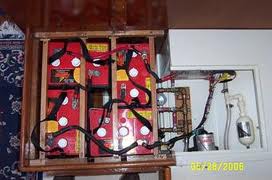 The following article is from Gavin Sorrell of Professional Solar Designs Australia who adds his sensible comments for the cruising sailor to browse and assimilate:
The following article is from Gavin Sorrell of Professional Solar Designs Australia who adds his sensible comments for the cruising sailor to browse and assimilate:'The battery, reports Gavin is something that boatowners buy, install in the least attractive part of the vessel and then forget, until something goes wrong.'
Together with loss of cooling water, the battery and its associated wiring is probably the prime culprit in disabling boats.
In a car, the battery provides a short burst of high current to start the engine. Then the alternator quickly replenishes the charge so that the battery is seldom below its full capacity. However, in a boat, the engine is run relatively infrequently, often specifically to charge the battery; and other means of charging such as solar, wind or shorepower are available intermittently.
Boat electrical systems are called upon to operate even when no charging is available, which requires a battery that can provide current at a low but steady rate for long periods between recharging. Hence the requirement for a deep cycle battery in addition to the engine cranking battery.
 In a traditional battery, lead plates are suspended in an acid electrolyte. The chemical reaction between the lead and the acid creates the current flow. Lead is eroded from the plates and once it is depleted, the reaction slows and current reduces. By applying power from an external source, the chemical process is reversed, lead is deposited back on the plates and the battery is recharged.
In a traditional battery, lead plates are suspended in an acid electrolyte. The chemical reaction between the lead and the acid creates the current flow. Lead is eroded from the plates and once it is depleted, the reaction slows and current reduces. By applying power from an external source, the chemical process is reversed, lead is deposited back on the plates and the battery is recharged. The rate of electricity flow, in amps (A) is proportional to the area of lead exposed to the acid. A high current results from many very thin plates in a battery. Such a battery will give a short burst of energy that will rapidly diminish as the plates are eroded. This battery is ideal for starting which requires a high, brief cranking current.
The alternative is to use thicker plates, so that long term surface plate erosion is reduced. But fewer thick plates can occupy a battery case and the lead surface exposed to the electrolyte is reduced, resulting in a battery that can supply only low current for a long time. This is a deep cycle battery, able to supply relatively low current to run the electrical and electronic systems for sustained periods and also able to accept far more charge/discharge cycles than a dedicated starting battery.
Typical criteria to compare battery capabilities are: Cold Cranking Amperage or CCA: An indication of the ability of a battery to crank an engine or for powering winches or thrusters, defined as the discharge load measured in A that a battery operating at -17.8°C can deliver for 30 seconds whilst maintaining the voltage above 7.2 V.
 Obviously this temperature is unlikely to be experienced in Australia, but conforms to a global standard.
Obviously this temperature is unlikely to be experienced in Australia, but conforms to a global standard. The 20 hour discharge rating, measured in Amp-hours (Ah): This rating indicates the ability to deliver current over a protracted period. A 100Ah battery theoretically delivers 1A for 100 hours or 2A for 50 hours. But no deep cycle battery should be discharged below 50% of its rated capacity. Also, the capacity depends on the discharge rate due to the rate at which the chemical reaction occurs. So more Amp-hours can be drawn from a battery at a low current rate. That is why the discharge time is specified for the Ah rating, typically 20 hours.
Selecting a battery system that can perform both cranking and deep cycle functions is therefore a compromise. This is one of the main reasons that a boat is fitted with two battery banks, one with a high CCA rating to start the engine and another, often called the house battery, with good deep cycle characteristics to run the electrical systems. The other reason is of course that by having a separate starting battery, it can be isolated from the house loads, thus ensuring that sufficient cranking ability is available to start the engine even if the house battery is flat.'
Article courtesy Gavin Sorrell and Afloat magazine, images courtesy Aflopat magazine and boatfix.com
There is also an interesting article regarding the setting up sequence for your batteries at www.boatfix.com
No comments:
Post a Comment